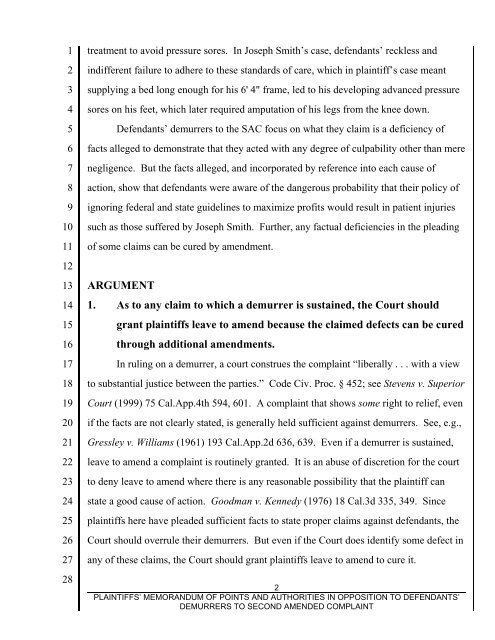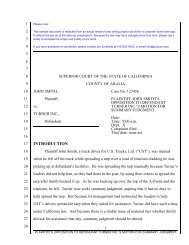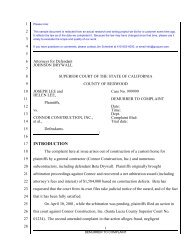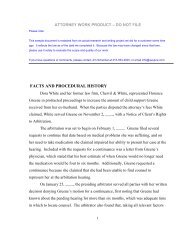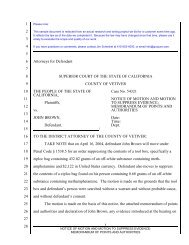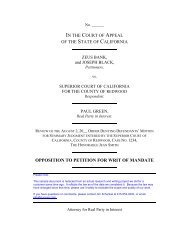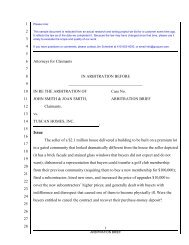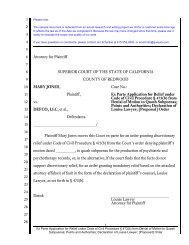Opposition to Demurrer - Quo Jure Corporation
Opposition to Demurrer - Quo Jure Corporation
Opposition to Demurrer - Quo Jure Corporation
Create successful ePaper yourself
Turn your PDF publications into a flip-book with our unique Google optimized e-Paper software.
1<br />
2<br />
3<br />
4<br />
5<br />
6<br />
7<br />
8<br />
9<br />
10<br />
11<br />
12<br />
13<br />
14<br />
15<br />
16<br />
17<br />
18<br />
19<br />
20<br />
21<br />
22<br />
23<br />
24<br />
25<br />
26<br />
27<br />
28<br />
treatment <strong>to</strong> avoid pressure sores. In Joseph Smith’s case, defendants’ reckless and<br />
indifferent failure <strong>to</strong> adhere <strong>to</strong> these standards of care, which in plaintiff’s case meant<br />
supplying a bed long enough for his 6' 4" frame, led <strong>to</strong> his developing advanced pressure<br />
sores on his feet, which later required amputation of his legs from the knee down.<br />
Defendants’ demurrers <strong>to</strong> the SAC focus on what they claim is a deficiency of<br />
facts alleged <strong>to</strong> demonstrate that they acted with any degree of culpability other than mere<br />
negligence. But the facts alleged, and incorporated by reference in<strong>to</strong> each cause of<br />
action, show that defendants were aware of the dangerous probability that their policy of<br />
ignoring federal and state guidelines <strong>to</strong> maximize profits would result in patient injuries<br />
such as those suffered by Joseph Smith. Further, any factual deficiencies in the pleading<br />
of some claims can be cured by amendment.<br />
ARGUMENT<br />
1. As <strong>to</strong> any claim <strong>to</strong> which a demurrer is sustained, the Court should<br />
grant plaintiffs leave <strong>to</strong> amend because the claimed defects can be cured<br />
through additional amendments.<br />
In ruling on a demurrer, a court construes the complaint “liberally . . . with a view<br />
<strong>to</strong> substantial justice between the parties.” Code Civ. Proc. § 452; see Stevens v. Superior<br />
Court (1999) 75 Cal.App.4th 594, 601. A complaint that shows some right <strong>to</strong> relief, even<br />
if the facts are not clearly stated, is generally held sufficient against demurrers. See, e.g.,<br />
Gressley v. Williams (1961) 193 Cal.App.2d 636, 639. Even if a demurrer is sustained,<br />
leave <strong>to</strong> amend a complaint is routinely granted. It is an abuse of discretion for the court<br />
<strong>to</strong> deny leave <strong>to</strong> amend where there is any reasonable possibility that the plaintiff can<br />
state a good cause of action. Goodman v. Kennedy (1976) 18 Cal.3d 335, 349. Since<br />
plaintiffs here have pleaded sufficient facts <strong>to</strong> state proper claims against defendants, the<br />
Court should overrule their demurrers. But even if the Court does identify some defect in<br />
any of these claims, the Court should grant plaintiffs leave <strong>to</strong> amend <strong>to</strong> cure it.<br />
2<br />
PLAINTIFFS’ MEMORANDUM OF POINTS AND AUTHORITIES IN OPPOSITION TO DEFENDANTS’<br />
DEMURRERS TO SECOND AMENDED COMPLAINT


